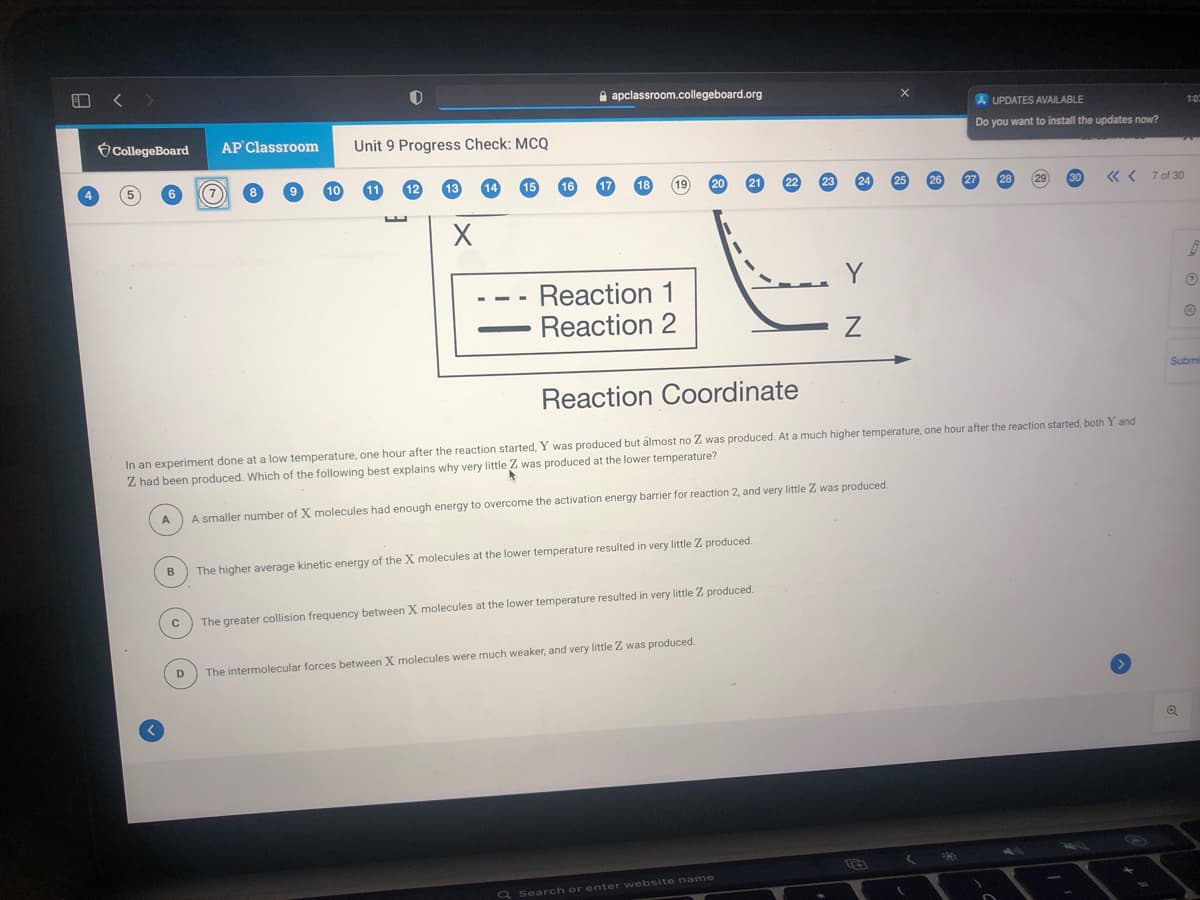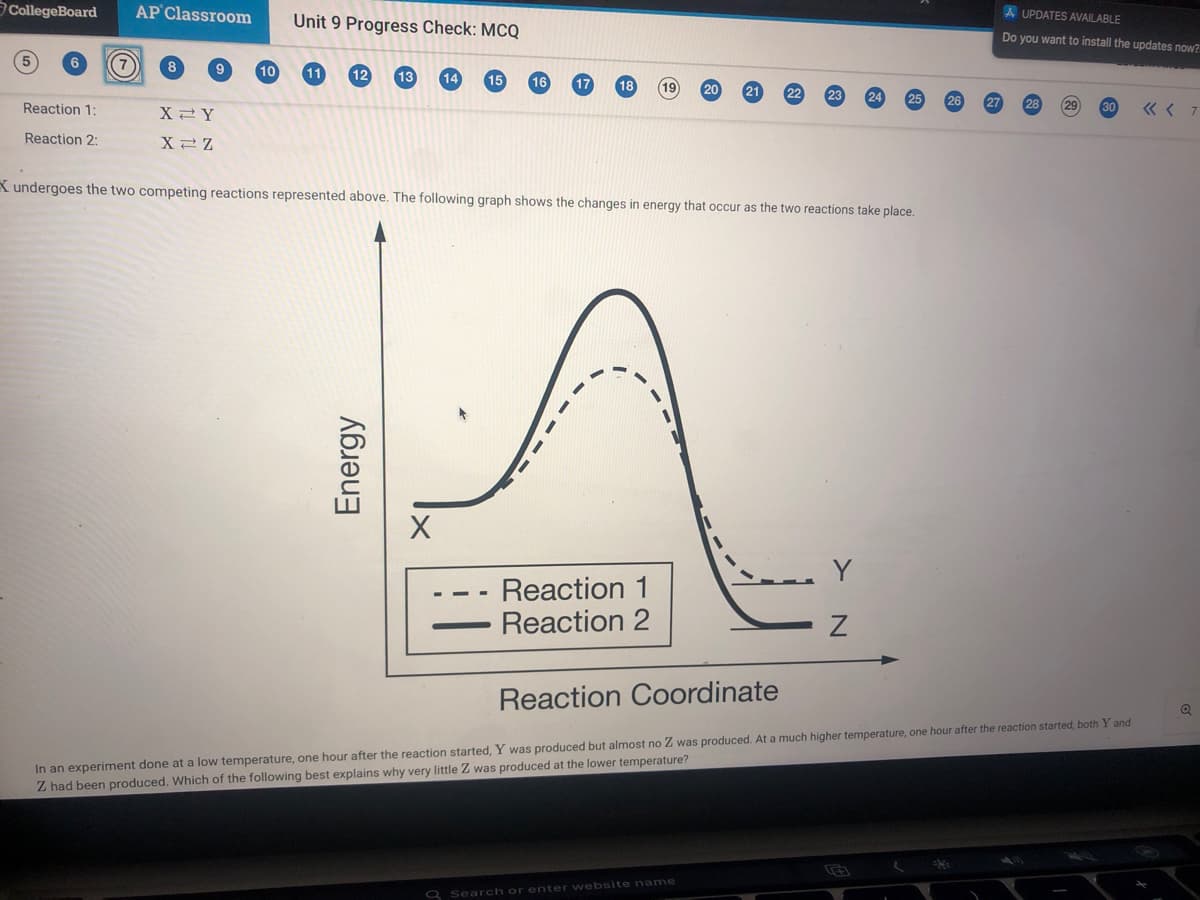7 of 3 Y Reaction 1 Reaction 2 -- . Reaction Coordinate In an experiment done at a low temperature, one hour after the reaction started, Y was produced but almost no Z was produced. At a much higher temperature, one hour after the reaction started, both Y and Z had been produced. Which of the following best explains why very little Z was produced at the lower temperature? A A smaller number of X molecules had enough energy to overcome the activation energy barrier for reaction 2, and very little Z was produced в The higher average kinetic energy of the X molecules at the lower temperature resulted in very little Z produced. The greater collision frequency between X molecules at the lower temperature resulted in very little Z produced. The intermolecular forces between X molecules were much weaker, and very little Z was produced.
7 of 3 Y Reaction 1 Reaction 2 -- . Reaction Coordinate In an experiment done at a low temperature, one hour after the reaction started, Y was produced but almost no Z was produced. At a much higher temperature, one hour after the reaction started, both Y and Z had been produced. Which of the following best explains why very little Z was produced at the lower temperature? A A smaller number of X molecules had enough energy to overcome the activation energy barrier for reaction 2, and very little Z was produced в The higher average kinetic energy of the X molecules at the lower temperature resulted in very little Z produced. The greater collision frequency between X molecules at the lower temperature resulted in very little Z produced. The intermolecular forces between X molecules were much weaker, and very little Z was produced.
Chapter17: Spontaneity, Entropy, And Free Energy
Section: Chapter Questions
Problem 23Q: Monochloroethane (C2H5Cl) can be produced by the direct reaction of ethane gas (C2H6) with chlorine...
Related questions
Question

Transcribed Image Text:A apclassroom.collegeboard.org
A UPDATES AVAILABLE
1:07
CollegeBoard
AP Classroom
Unit 9 Progress Check: MCQ
Do you want to install the updates now?
(7)
« < 7 of 30
Reaction 1
Reaction 2
Submi
Reaction Coordinate
In an experiment done at a low temperature, one hour after the reaction started, Y was produced but almost no Z was produced. At a much higher temperature, one hour after the reaction started, both Y and
Z had been produced. Which of the following best explains why very little Z was produced at the lower temperature?
A
A smaller number of X molecules had enough energy to overcome the activation energy barrier for reaction 2, and very little Z was produced.
The higher average kinetic energy of the X molecules at the lower temperature resulted in very little Z produced
The greater collision frequency between X molecules at the lower temperature resulted in very little Z produced.
The intermolecular forces between X molecules were much weaker, and very little Z was produced.
D
Q Search or enter website name

Transcribed Image Text:CollegeBoard
AP Classroom
A UPDATES AVAILABLE
Unit 9 Progress Check: MCQ
Do you want to install the updates now?
8
9
10
11
13
Reaction 1:
X2Y
30
Reaction 2:
K undergoes the two competing reactions represented above. The following graph shows the changes in energy that occur as the two reactions take place.
Y
Reaction 1
Reaction 2
Reaction Coordinate
In an experiment done at a low temperature, one hour after the reaction started, Y was produced but almost no Z was produced. At a much higher temperature, one hour after the reaction started, both Y and
Z had been produced. Which of the following best explains why very little Z was produced at the lower temperature?
O Search or enter website name
Energy
Expert Solution
This question has been solved!
Explore an expertly crafted, step-by-step solution for a thorough understanding of key concepts.
This is a popular solution!
Trending now
This is a popular solution!
Step by step
Solved in 2 steps with 2 images

Knowledge Booster
Learn more about
Need a deep-dive on the concept behind this application? Look no further. Learn more about this topic, chemistry and related others by exploring similar questions and additional content below.Recommended textbooks for you


Chemistry
Chemistry
ISBN:
9781305957404
Author:
Steven S. Zumdahl, Susan A. Zumdahl, Donald J. DeCoste
Publisher:
Cengage Learning

Chemistry: An Atoms First Approach
Chemistry
ISBN:
9781305079243
Author:
Steven S. Zumdahl, Susan A. Zumdahl
Publisher:
Cengage Learning


Chemistry
Chemistry
ISBN:
9781305957404
Author:
Steven S. Zumdahl, Susan A. Zumdahl, Donald J. DeCoste
Publisher:
Cengage Learning

Chemistry: An Atoms First Approach
Chemistry
ISBN:
9781305079243
Author:
Steven S. Zumdahl, Susan A. Zumdahl
Publisher:
Cengage Learning

Chemistry for Engineering Students
Chemistry
ISBN:
9781337398909
Author:
Lawrence S. Brown, Tom Holme
Publisher:
Cengage Learning

Chemistry for Engineering Students
Chemistry
ISBN:
9781285199023
Author:
Lawrence S. Brown, Tom Holme
Publisher:
Cengage Learning

Chemistry: Principles and Practice
Chemistry
ISBN:
9780534420123
Author:
Daniel L. Reger, Scott R. Goode, David W. Ball, Edward Mercer
Publisher:
Cengage Learning